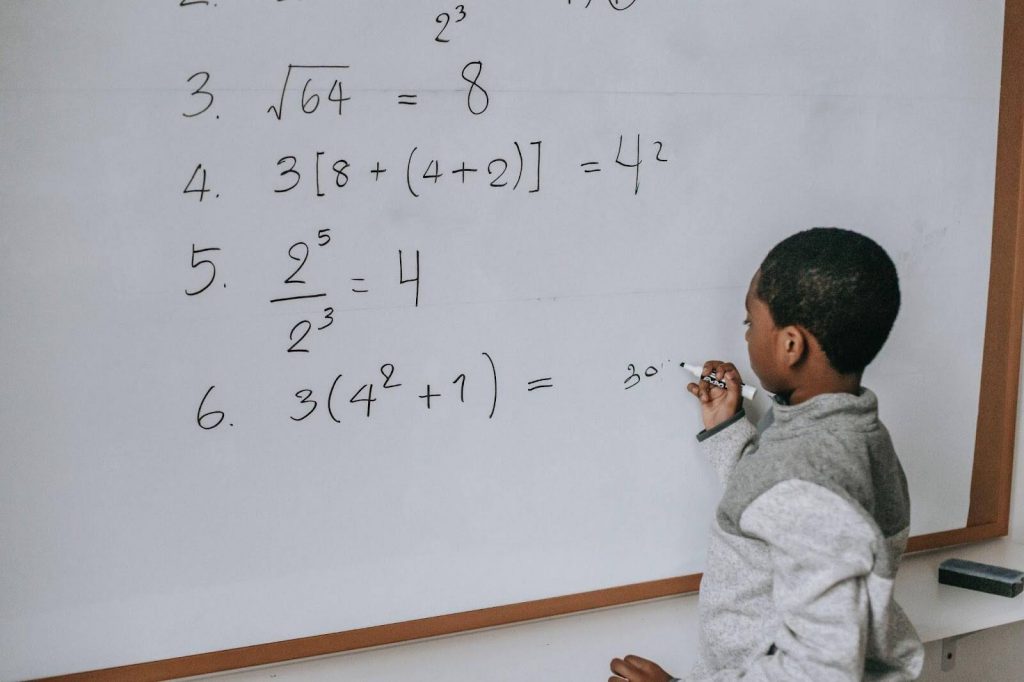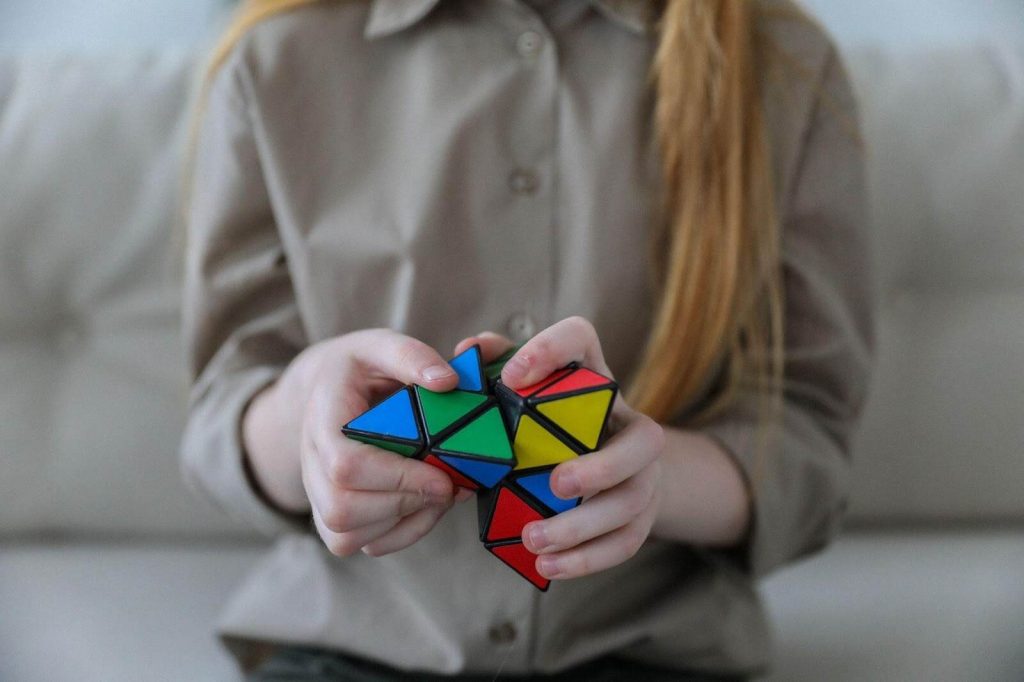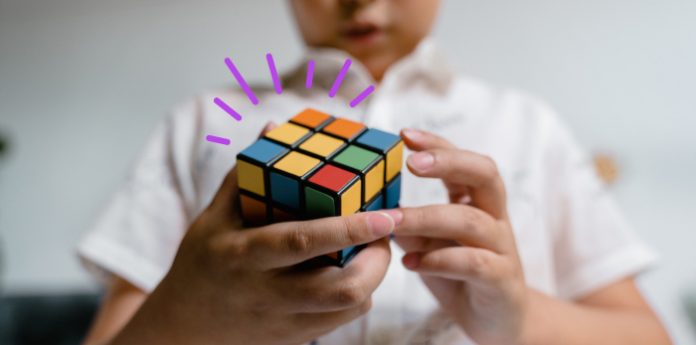Most kids love puzzles. They’re fun and help develop problem-solving skills. But what if you could combine puzzles with math? That’s precisely what math puzzles do, and kids may not even realize they’re learning.
Math & ELA | PreK To Grade 5
Kids see fun.
You see real learning outcomes.
Watch your kids fall in love with math & reading through our scientifically designed curriculum.
Parents, try for free Teachers, use for free
Math puzzles for kids can be a great way to teach them essential skills such as logic, pattern recognition, and critical thinking. They are perfect for reinforcing essential math skills, from addition and subtraction to multiplication and division. More so, they also make kids’ brains active!
Math puzzles are great for students of all ages. Younger kids can practice their counting and skip counting skills, while older kids can flex their algebra muscles.
10 Math Puzzles for Kids

Check out these exciting math puzzles for upper elementary and middle school. This is a great list to have on hand when you need something fun and challenging for your students.
Math Puzzles for Beginners

The advantage of these puzzles is that even the very young can solve them. As long as your child can recognize letters and read simple words, there is no reason why their math skills can’t be given a boost by doing some of these puzzles.
1. Math Crossword Puzzles
Crossword puzzles are one of the most significant sources of entertainment and an excellent way to pass the time. The main goal is to find words within a grid. Each word must contain the same number of letters as the grid has rows (or columns). The faster you complete the crossword puzzle, the better your score!
The basic idea behind math crossword puzzles is to present an equation to solve. For example, if the equation is 2 + 3 = 5, you need to figure out what number comes between 2 and 3, which is 4. You could also use addition or subtraction to get the correct answer. In this case, you would add 2 and 3 together to get 5.
2. Math Riddles
Riddles are a great way to get kids excited about math! Check out our list of riddles, and help your kids develop their math skills in a fun and engaging way:
Question 1: A farmer had 15 sheep. All but 9 ran away. How many sheep were left?
Answer: 9
Question 2: If three birds are sitting on a wire and you shoot one, how many birds are left on the wire?
Answer: none (because once you shoot one, the other two will fly away)
Question 3: I am an odd number. Take away one letter and I become even. What number am I?
Answer: Seven.
Question 4: You ran a race and passed the person in second place. What place would you be in now?
Answer: You would be in second place because you passed the person in second place!
Question 5: A man has four daughters, each of whom has a brother. How many children are in the family?
Answer: 5
Math Puzzles & Games for Elementary Kids
1. SplashLearn
SplashLearn is an enjoyable online platform that teaches children math in a fun way. It is the perfect learning tool for kids when they start dreading math.
Teachers can use SplashLearn for elementary school students struggling with reading or writing or for middle-school students struggling with math skills. You can also use it to help your older children learn addition and subtraction in a fun way through games!
It is fun to learn math for children in grades K—5. SplashLearn covers topics from addition, subtraction, multiplication, and division to fractions and geometry. It is based on the Common Core standards and has multiple practice problems for each subject.
2. Domino Puzzle Board
Kids love playing with dominoes. Domino is a game where you need to match the number of dots on one tile with another. It is so much fun. Moreover, it can be used as a mathematical learning tool for children.
The simple addition of the numbers on the dominoes builds up children’s confidence in doing math and makes them more confident in solving complex problems.
Children can play with their friends by placing the pieces on their boards and matching numbers with other players’ boards. This game helps develop social interaction skills while learning math simultaneously!
The Domino puzzle board is excellent for teaching children how to easily count, add, and subtract! The pieces are easy enough for kids as young as three but still challenging enough that they won’t get bored quickly either (and they might even like playing more than once).
3. Sudoku
The game of Sudoku is all about logic and problem-solving. It is a game of numbers that people of all ages can enjoy. The game’s objective is to fill in the 9×9 grids with digits pointed out below. In other words, each column, row, and 3×3 box should have each number only once.
Sudoku is one of the most fun and popular math puzzle games. The goal of Sudoku is to fill a 9×9 grid with numbers so that each row, column, and 3×3 section contains all of the digits between 1 and 9.
As a logic puzzle, Sudoku is also an excellent brain game. If your students play Sudoku daily, you will soon see improved concentration and overall brain power. Sudoku free puzzles will be your students’ favorite math game within no time.
It helps improve their logical reasoning skills by focusing on details and paying attention to things around them. They will develop the ability to think critically about solving the puzzle step-by-step. This will also help them improve their ability to solve problems at school.
Math Puzzles for Intermediate and Advanced Learners

Mathematics can be complicated, but if children understand the basics, it will be easier for them. They need to get the basics before moving on to more complex calculus and algebra.
The math puzzles presented here are selected for the deceptive simplicity of their statement or the elegance of their solution. They are designed for intermediate students, but many may even challenge advanced students.
1. Pattern Math Puzzles
Pattern Puzzles are a great way to get your students talking. They are exciting and fun to solve, and they help students use their minds in new ways. Teachers can use them as conversation starters or icebreakers, review activities, or group-based problem-solving tasks.
Pattern puzzles are a sub-class of Put-Together puzzles. In these puzzles, you’re presented with shapes, and you have to arrange them to fit inside one or more outlines. Some of the outlines may include instructions like “place a triangle here” or hints like “there should be three squares in this row.”
Pattern puzzles do not usually require the solver to deduce the pattern used to solve the puzzle. The solver has to use logic to determine where each piece goes.
2. Arithmetic Math Puzzles
Arithmetic puzzles are an excellent way for students to practice their math skills and have fun at the same time. These puzzles can also be a perfect way to introduce new topics or review ones students have already mastered.
These puzzles are fun and engaging while teaching children basic math skills. Each puzzle has a mathematical problem that children must solve by solving simple math problems, including addition, subtraction, multiplication, and division.
- A man walking in the street meets his friend and says to him: ” My daughter has just had as many children as I have. Each of her children has the same number of brothers as it has sisters. Each of my sons has twice as many sisters as he has brothers. How many children does my daughter have?”
The friend replies: “I am sorry, I cannot solve this problem. Can you give me another hint?”
The man says: “Well, in that case, I can tell you that each of my daughters has one more brother than she has sisters.”
“what is the answer?
Answer: 4 girls and one boy (three girls, two girls, and one boy)
- What is the value of one-half of one-fifth of one-tenth of 400?
Answer: 2
- What is the sum of the digits of all numbers from 1 to 999?
Answer: 270000
- A thief has a very clever strategy when stealing the number plates of cars. Whenever he steals a number plate, he changes it with the help of a magic machine, and the altered number becomes two times the original number. If the new number is odd, he leaves it as such. The machine changes it into the next higher odd number if it is even.
What will be the new number after three such changes?
Answer: 12
3. Boxes Puzzle
Boxes Puzzles is a box-type logic puzzle about boxes with colors and symbols. The goal is to arrange the boxes according to the numbers and signs around the grid. In each puzzle, there are clues in various places that indicate the layout of the boxes.
Students can solve puzzles by deducing the contents of individual cells from combinations of grouping, intersections, and numbers given in the rows, columns, and blocks. The basic idea behind solving box puzzles is that you want to reduce the number of possibilities for each box until you’ve narrowed it down to only one option.
4. Algebra Math Puzzles
There are a lot of riddles and puzzles that can be solved using algebraic equations. Solving equations isn’t always easy, but it does allow you to find answers to all sorts of things. These algebra puzzles are an excellent way to practice manipulating formulas and solving them for different variables.
- Find x, given the following equation:
6×2 + 3y2 = 24y – 7x
Answer: x = 4
- Find y, given the following equation:
3×2 – 6xy + 3y2 = 12
Answer: y = 6
- Find x, given the following equation:
y2 – 9y + x2 – 5x + 10 = 0 (where x < y)
Answer: x = 1
5. Logic Puzzle
Advanced Logic Puzzles is a new and exciting series that challenges even the most skilled puzzle solver. Logic puzzles are a great way to test your students’ analytical prowess in a fun, interactive way.
The puzzles often take the form of a question-and-answer riddle. For example: “What occurs once in a minute, twice in a moment, but never in a thousand years?” The answer is the letter ‘m’ by identifying and manipulating the relevant information. Below are four logic puzzles that have been sourced from around the internet and are designed to challenge more advanced learners.
- You’re walking down the street when you see a man who stops to talk to another man. The first man then removes his hat and shakes the other’s hand. The second man does not shake hands with the first. What is the relationship between these two men?
Answer: The men are brothers.
- At sixteen years old, Mary is four times as old as her brother. How old will Mary be when she is twice as old as her brother?
Answer: Mary will be 20 years old when she is twice as old as her brother.
- If a doctor and a boy are fishing and catch one fish, the boy gets it. If they catch more than one fish, the doctor gets half of them. If they catch two fish, how can the doctor get only one?
Answer: The doctor got one fish, and the boy got none.
- A farmer has a fox, a chicken, and a bag of corn. He wants to cross the river with them, but his boat is only big enough to carry one at a time. If he leaves the fox with the chicken, the fox will eat the chicken. If he leaves the chicken with the corn, the chicken will eat the corn. How can he take all three across safely?
Answer: The farmer will take the chicken with him and cross the river. He will leave the chicken on the other side and come back. Since the fox will not eat the corn, he will take the fox and cross the river.
He will leave the fox on the other side and bring the chicken to the original side. He will leave the chicken and take the corn since the chicken will eat the corn.
But the fox won’t eat the corn, so the fox and corn are on the other side. He will leave to return and get the chicken.
The Importance of Using Math Puzzles in the Classroom

These math puzzles engage students, but they also help them develop fluency and accuracy in math skills. They can be used as a learning mechanism to help students learn the subject in the most interactive way possible.
The beauty of puzzles is that they can be adapted for varying degrees of difficulty. Furthermore, this practice exercises the mind to help reduce stress and prepare it to think outside the box.
Learning math is often a tedious task for students, and most students seem to dislike it. A playful approach, such as math puzzles in the classroom, is practical for engaging students by bringing math to life and putting it into perspective so they don’t see it as one of their lesser favorite subjects.
So, how can you make math fun in the classroom? Incorporating games into the curriculum is what SplashLearn does. Splashlearn is committed to the continued growth and education of students in math – and beyond.
Frequently Asked Questions
What is a puzzle in math?
A puzzle is a thing that is difficult to understand or explain. The term also refers to a game, toy, or problem designed to test ingenuity or knowledge. Math puzzles are problems that require mathematical logic and calculation.
What is a number puzzle?
A cross-figure (also variously called cross number puzzle or figure logic) is a puzzle similar to a crossword in structure. Except, entries consist of numbers rather than words, with individual digits entered in the blank cells.
Which is better: Sudoku or crossword?
Sudoku maybe math math-based, but it’s of the relatively essential and not very useful kind. Finally, crosswords are more fun.
How do crossword puzzles help your brain?
Research shows doing crossword puzzles can also improve your ability to focus attention on the desired task and improve your executive function and working memory.
























